How to Apply Eye Makeup After Blepharoplasty?

Table of contents
Blepharoplasty (eyelid surgery) can refresh your appearance and boost your confidence, but patients are often eager to know when and how they can safely return to their usual beauty routines—especially applying eye makeup. Proper techniques and timing are crucial for protecting your healing eyelids and ensuring you enjoy the best results from your procedure. This guide will help you navigate makeup application after blepharoplasty with confidence and care. It’s natural to feel eager to return to your full makeup routine and show off your rejuvenated eyes, but patience is essential during this time. Every person heals at his or her own pace, and the eyelid area is particularly sensitive. By waiting until your surgeon gives you the green light and easing into eye makeup gradually, you’ll not only avoid setbacks but also protect the quality and longevity of your results. Remember, the first weeks are about healing—there will be plenty of time to experiment with new looks and products once you’re fully recovered.
If your surgeon has recommended post-op ointments or moisturizers, apply them gently with clean fingertips as the final step in your nighttime routine. Be mindful of the products’ expiration dates and consider replacing eye makeup and removal products regularly to minimize the risk of contamination. Establishing this gentle, consistent makeup removal habit not only helps safeguard your surgical results but also promotes overall eyelid health and comfort in the months and years to come.